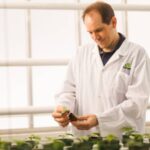Adapting to Change
If you would have told me six years ago that I would be writing an article about sales instead of growing, I probably would not have believed it — but here we are. I love growing plants, watching racks of plants get loaded onto trucks, the deafening crescendo of spring where you have no idea how you will get it all planted, grown, and shipped; these are things I lived off of for 15 years.
I had always wanted to try sales, and thanks to my loving wife for her support and Berger for the opportunity, I found out that, not only am I actually good at it, I really enjoy it as well. Being able to see other growing operations all over the country has been an exhilarating and humbling experience to say the least. The creativity, intelligence and adaptability of the people in this industry reminds me every day how proud I am to be a part of this horticultural family.

Adaptability is an incredible trait and very apt for this industry. Headwinds within the industry, such as rising minimum wage and labor shortages, have forced us all to become creative in how we perform our jobs every day. Automation has become a necessity for growers of all sizes. Transplanters, conveyor belts and soil processing equipment have become a more and more common sight in my travels. Loose fill or bulk soil has been replaced by compressed bales and skyscrapers. A mentor once told me every time a pot is touched, you lose a dime of margin — and that was 15 years ago.
Compressed mix and processing equipment is becoming a much more common sight today than just five years ago. The change from bulk soil and loose fill material to compressed mix — once thought of as only needed for large growers — is quickly becoming status quo for growers of all sizes. The elimination of a person dumping loose bags, or a skilled employee being on a skid steer, is realized very quickly. This allows a grower to either eliminate these positions, or move them to a value-added task such as loading plants that add to the bottom line. Yes, the cost of equipment is a large expense, but if you look at the ROI over time, can these operations afford not to invest?
Wood fiber, wood fiber, wood fiber! There has not been an aggregate on the market that has made such a splash since wood fiber. Berger has been at the forefront of this movement, and we have all seen it expand from a few growers trying it to many growers using or asking about it. From everything I have seen, the positives of wood fiber far outweigh any potential challenges there might be. The key to these mixes is still a high-quality sphagnum peat, which continues to be the main ingredient in soilless mixes. As a perlite alternative, the comment I hear most is water management in the first 15 to 20 days until crops root out and establish themselves is the most critical time.
Of the many positive comments I have heard are faster turn times and less dust on the production line. On the compression side, wood fiber is highly compressible in a mix, averaging up to an extra cubic yard per 110-cubic-foot skyscraper. We are learning so much more everyday about wood fiber, and there is still so much more to learn. Can we reduce fertilizer rates, and drench rates of plant growth regulators, insecticide, or fungicide? Are there any crops it will not work on? It is an extremely interesting time to be looking at all these options.
Vegetable and organic production is another segment I feel continues to grow and shows no sign of stopping. More people are planting vegetable gardens or buying patio containers for fresh food at home. A boon for growers is fast crop time, and low inputs always add to the bottom line. Organic production — if you are willing to undertake the certification — continues to grow every year, with 2019 at a $6 billion organic food market. Millennial customers are a little more discerning in where their food comes from and are willing to pay a higher dollar than a conventionally produced crop.
These are but a few of the many trends, changes and ingenuity of this industry. With more time I could expand upon new genetics, new aggregates, cannabis and hemp, vertical farming, and stabilized soil for plug and liners, as well as innumerable others that are driving change. Without a doubt, our ability as an industry to adapt and change has fueled growth in the 22 years I have been in horticulture. I am positive that even with all the challenges that we face, if collectively we stay positive and continue to adapt, the horticulture industry as a whole will continue to grow, thrive, and prosper for an extremely long time.









 Video Library
Video Library 


















